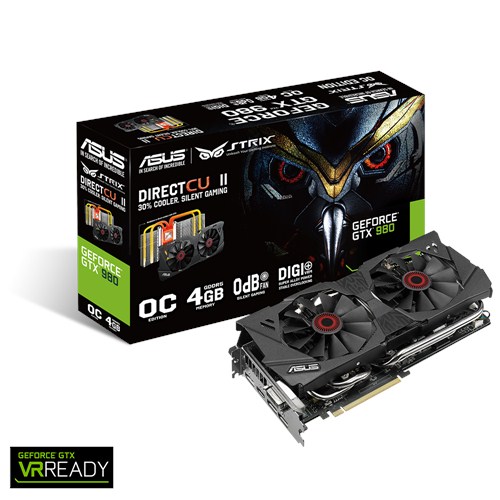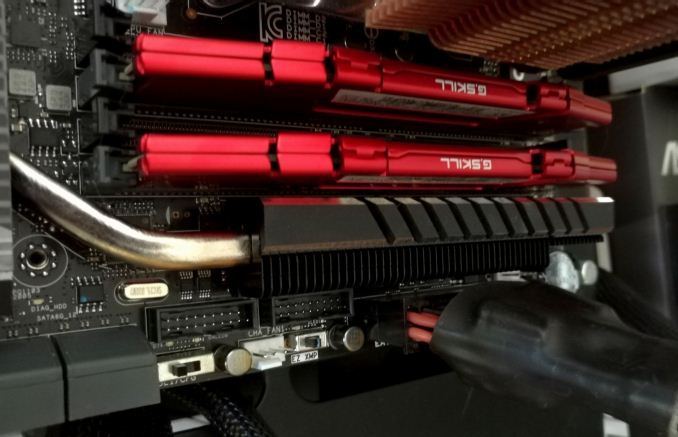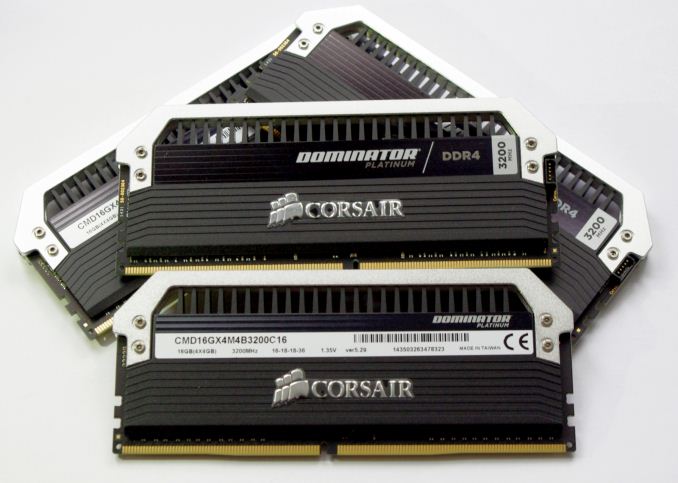The ASUS X99-E-10G WS Motherboard Review: 10GBase-T Networking with Intel’s X550-AT2
by Ian Cutress on November 7, 2016 9:00 AM EST- Posted in
- Motherboards
- Intel
- Asus
- 10G Ethernet
- X99
- 10GBase-T
- X99-E-10G WS
- X550
- X550-AT2
Test Bed and Setup
As per our testing policy, we take a high-end CPU suitable for the motherboard that was released during the socket’s initial launch, and we equip the system with a suitable amount of memory running at the processor maximum supported frequency. This is also typically run at JEDEC subtimings where possible. It is noted that some users are not keen on this policy, stating that sometimes the maximum supported frequency is quite low, or faster memory is available at a similar price, or that the JEDEC speeds can be prohibitive for performance. While these comments make sense, ultimately very few users apply memory profiles (either XMP or other) as they require interaction with the BIOS, and most users will fall back on JEDEC supported speeds - this includes home users as well as industry who might want to shave off a cent or two from the cost or stay within the margins set by the manufacturer. Where possible, we will extend out testing to include faster memory modules either at the same time as the review or a later date.
| Test Setup | |
| Processor | Intel Core i7-5960X ES 8 Cores, 16 Threads, 3.0 GHz (3.5 GHz Turbo) |
| Motherboards | ASUS X99-E-10G WS |
| Cooling | Cooler Master Nepton 140XL |
| Power Supply | OCZ 1250W Gold ZX Series Corsair AX1200i Platinum PSU |
| Memory | Corsair DDR4-2133 C15 4x8 GB 1.2V or G.Skill Ripjaws 4 DDR4-2133 C15 4x8 GB 1.2V |
| Memory Settings | JEDEC @ 2133 |
| Video Cards | ASUS GTX 980 Strix 4GB MSI GTX 770 Lightning 2GB (1150/1202 Boost) ASUS R7 240 2GB |
| Hard Drive | Crucial MX200 1TB |
| Optical Drive | LG GH22NS50 |
| Case | Open Test Bed |
| Operating System | Windows 7 64-bit SP1 |
Readers of our motherboard review section will have noted the trend in modern motherboards to implement a form of MultiCore Enhancement / Acceleration / Turbo (read our report here) on their motherboards. This does several things, including better benchmark results at stock settings (not entirely needed if overclocking is an end-user goal) at the expense of heat and temperature. It also gives an essence of an automatic overclock which may be against what the user wants. Our testing methodology is ‘out-of-the-box’, with the latest public BIOS installed and XMP enabled, and thus subject to the whims of this feature. It is ultimately up to the motherboard manufacturer to take this risk – and manufacturers taking risks in the setup is something they do on every product (think C-state settings, USB priority, DPC Latency / monitoring priority, overriding memory sub-timings at JEDEC). Processor speed change is part of that risk, and ultimately if no overclocking is planned, some motherboards will affect how fast that shiny new processor goes and can be an important factor in the system build.
For reference, the ASUS X99-E-10G WS, on our testing BIOS 0402, MCT was enabled by default. In the event that users buy a board and the BIOS is still a development version (under 0402), we suggest that users update to at least 0402, as before this we experienced sub-optimal performance on development versions before 0402.
Many thanks to...
We must thank the following companies for kindly providing hardware for our multiple test beds. Some of this hardware is not in this test bed specifically, but is used in other testing.
Thank you to AMD for providing us with the R9 290X 4GB GPUs. These are MSI branded 'Gaming' models, featuring MSI's Twin Frozr IV dual-fan cooler design and military class components. Bundled with the cards is MSI Afterburner for additional overclocking, as well as MSI's Gaming App for easy frequency tuning.
The R9 290X is a second generation GCN card from AMD, under the Hawaii XT codename, and uses their largest Sea Islands GPU die at 6.2 billion transistors at 438mm2 built at TSMC using a 28nm process. For the R9 290X, that means 2816 streaming processors with 64 ROPs using a 512-bit memory bus to GDDR5 (4GB in this case). The official power rating for the R9 290X is 250W.
The MSI R9 290X Gaming 4G runs the core at 1000 MHz to 1040 MHz depending on what mode it is in (Silent, Gaming or OC), and the memory at 5 GHz. Displays supported include one DisplayPort, one HDMI 1.4a, and two dual-link DVI-D connectors.
Further Reading: AnandTech's AMD R9 290X Review
Thank you to ASUS for providing us with GTX 980 Strix GPUs. At the time of release, the STRIX brand from ASUS was aimed at silent running, or to use the marketing term: '0dB Silent Gaming'. This enables the card to disable the fans when the GPU is dealing with low loads well within temperature specifications. These cards equip the GTX 980 silicon with ASUS' Direct CU II cooler and 10-phase digital VRMs, aimed at high-efficiency conversion. Along with the card, ASUS bundles GPU Tweak software for overclocking and streaming assistance.
The GTX 980 uses NVIDIA's GM204 silicon die, built upon their Maxwell architecture. This die is 5.2 billion transistors for a die size of 298 mm2, built on TMSC's 28nm process. A GTX 980 uses the full GM204 core, with 2048 CUDA Cores and 64 ROPs with a 256-bit memory bus to GDDR5. The official power rating for the GTX 980 is 165W.
The ASUS GTX 980 Strix 4GB (or the full name of STRIX-GTX980-DC2OC-4GD5) runs a reasonable overclock over a reference GTX 980 card, with frequencies in the range of 1178-1279 MHz. The memory runs at stock, in this case 7010 MHz. Video outputs include three DisplayPort connectors, one HDMI 2.0 connector and a DVI-I.
Further Reading: AnandTech's NVIDIA GTX 980 Review
Thank you to Cooler Master for providing us with Nepton 140XL CLCs. The Nepton 140XL is Cooler Master's largest 'single' space radiator liquid cooler, and combines with dual 140mm 'JetFlo' fans designed for high performance, from 0.7-3.5mm H2O static pressure. The pump is also designed to be faster, more efficient, and uses thicker pipes to assist cooling with a rated pump noise below 25 dBA. The Nepton 140XL comes with mounting support for all major sockets, as far back as FM1, AM2 and 775.
Further Reading: AnandTech's Cooler Master Nepton 140XL Review
Thank you to Corsair for providing us with an AX1200i PSU. The AX1200i was the first power supply to offer digital control and management via Corsair's Link system, but under the hood it commands a 1200W rating at 50C with 80 PLUS Platinum certification. This allows for a minimum 89-92% efficiency at 115V and 90-94% at 230V. The AX1200i is completely modular, running the larger 200mm design, with a dual ball bearing 140mm fan to assist high-performance use. The AX1200i is designed to be a workhorse, with up to 8 PCIe connectors for suitable four-way GPU setups. The AX1200i also comes with a Zero RPM mode for the fan, which due to the design allows the fan to be switched off when the power supply is under 30% load.
Further Reading: AnandTech's Corsair AX1500i Power Supply Review
Thank you to Crucial for providing us with MX200 SSDs. Crucial stepped up to the plate as our benchmark list grows larger with newer benchmarks and titles, and the 1TB MX200 units are strong performers. Based on Marvell's 88SS9189 controller and using Micron's 16nm 128Gbit MLC flash, these are 7mm high, 2.5-inch drives rated for 100K random read IOPs and 555/500 MB/s sequential read and write speeds. The 1TB models we are using here support TCG Opal 2.0 and IEEE-1667 (eDrive) encryption and have a 320TB rated endurance with a three-year warranty.
Further Reading: AnandTech's Crucial MX200 (250 GB, 500 GB & 1TB) Review
Thank you to G.Skill for providing us with memory. G.Skill has been a long-time supporter of AnandTech over the years, for testing beyond our CPU and motherboard memory reviews. We've reported on their high capacity and high-frequency kits, and every year at Computex G.Skill holds a world overclocking tournament with liquid nitrogen right on the show floor. One of the most recent deliveries from G.Skill was their 4x16 GB DDR4-3200 C14 Kit, which we are planning for an upcoming review.
Further Reading: AnandTech's Memory Scaling on Haswell Review, with G.Skill DDR3-3000
Thank you to Corsair for providing us with memory. Similarly, Corsair (along with PSUs) is also a long-time supporter of AnandTech. Being one of the first vendors with 16GB modules for DDR4 was a big deal, and now Corsair is re-implementing LEDs back on its memory after a long hiatus along with supporting specific projects such as ASUS ROG versions of the Dominator Platinum range. We're currently looking at our review pipeline to see when our next DRAM round-up will be, and Corsair is poised to participate.
Further Reading: AnandTech's Memory Scaling on Haswell-E Review

















63 Comments
View All Comments
Notmyusualid - Friday, December 2, 2016 - link
TB3 IS great! - but not for the use case you describe, I think.r3loaded - Monday, November 7, 2016 - link
So why exactly IS 10G so expensive? Is there some inherent technical reason, or is it just Intel doing what Intel does best with a captive market over which they have a near monopoly?jhh - Monday, November 7, 2016 - link
Volume. There is a certain amount of engineering involved in making the NIC, and if you expect to sell 100,000, you recoup that engineering expense differently than if you expect to sell 10,000,000. I'm sure the volume is somewhere between those two targets. Volume will be limited if for no other reason that most devices connect via WiFi, and that until WiFi routers come with something other than a 1G port, it's hard to drive the market for 10G. The server environment is different, but fewer servers are sold than laptop/tablet/phone. No one is selling > 1G Internet to the residential market, so even that option isn't driving the market. One is then limited to people with the need to transfer at more than 1G speeds within a residence, and that market is small. Servers tend to use fiber, as the signal processing to support 10G over copper was historically adding significant latency compared to fiber. Fiber is also more forward compatible to 25G than copper, as every speed transition has always required different cables. Unless you are installing Cat 7a wire and proprietary connectors, but they aren't directly compatible with 1G wiring.Communism - Monday, November 7, 2016 - link
http://ark.intel.com/products/84329/Intel-Ethernet...The price per thousand is down to 80 USD for the controller (Which provides 2x 10G base-t ports), meaning one could theoretically integrate it into an x99 (or the boards coming out for Skylake-E/X) for around that much if you could get enough traction to be able to put them in a board with a significant portion of sales.
This sounds entirely feasible, unfortunately, they seem to be stuck on boards that are made purely for manufacturer advertising with hilarious prices like 700 USD.
Integrating such a controller is simple, as it's just a PCIe 3.0 x4 device.
Hopefully at least 1 of the major board manufacturers starts making reasonable integrations with the X550-AT2 controller in the Skylake-E/X generation boards.
bronan - Friday, November 11, 2016 - link
Intel sold their 10G cards for under 100 dollar each, when companies jumped onto them they slowly upped the prices to the max. These cards can be sold for under 50 dollar each but the hunger for huge profits will not allow thatBillR - Tuesday, November 8, 2016 - link
Terrific answer. 1G is everywhere and cost for those ports shows the power of huge volumes on prices. However, 10G is mostly limited to servers and there is a lot of competition for server connections (25G, 40G, 50G, 100G, Infiniband, etc.). Unfortunately fragmentation means higher prices.Ranger1065 - Monday, November 7, 2016 - link
zzzZZzzz.....bronan - Friday, November 11, 2016 - link
These chips cost really nothing for the gaints, the real prices of these chips are absolute below 10 dollar each. Again intel sold full fledged pci cards if i remember well around 77 dollar thats consumer price. See what happened after the companies started adopted them. I can't believe everbody makes it look like it so expenssive to make chips.... They cost them a few bucks to make thats it not 50 dollar+ my company makes chips for certain installations they costs 0.04 cents each and are sold to companies for 11 cents each ... talking about making profit. Thats the real prices you as consumer pay for that same 11 cents .... 10 dollar+ yes thats how the market works these days enormous profit is all what countsnirsever - Tuesday, November 8, 2016 - link
In fact, the footprint of the Tehuti Networks based solutions with PHYs from either Marvell or Aquantia are way smaller than the Intel X550 and since they don't require a heat sink, consuming ~5W max (for both MAC and PHY), they are much easier to integrate. The Tehuti Networks solutions are already supporting 2.5G and 5G in addition to standard 10GBase-T. You can find Tehuti Networks based 5-speed NIC cards already selling today for ~$200 while this figure is expected to drop significantly once new Marvell 802.3bz PHYs will start shipping in volumes early next yearnirsever - Tuesday, November 8, 2016 - link
Please take a look at what you can expect from Tehuti Networks and Marvell new PHY:http://www.tehutinetworks.net/?t=LV&L1=3&L...